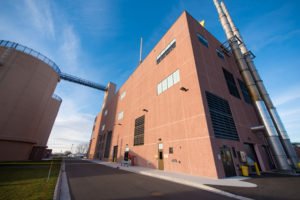Waste Into Fuel: A Water Infrastructure Success in Green Bay
Communities across the Great Lakes are struggling with aging drinking and waste water infrastructure that is vital to providing safe drinking water, and nonstop wastewater treatment services that protect public health.Thanks to federally funded programs such as the Clean Water State Revolving Fund and Drinking Water State Revolving Fund (SRF), communities that struggle with aging water infrastructure can get low-interest or no-interest loans and even loan forgiveness to upgrade these systems and protect communities and habitats over the long term.These federal programs use an innovative financing structure that ensures a long-term supply of low-interest or no-interest loans for towns, cities and municipalities that need infrastructure improvements. Green Bay, Wisconsin is one success story of the SRF put into action. NEW Water, the brand of the Green Bay Metropolitan Sewerage District, is perched at the edge of the Great Lakes, and serves about 236,000 residents, and cleans about 38 million gallons of water each day.More than ten years ago, NEW Water realized that its solids handling facility was nearing the end of its useful life. Leaving things be was not an option; a compromised system would have jeopardized the nonstop service Green Bay residents and businesses had come to expect.Leveraging SRF funding, NEW Water addressed this community need by building a new solids handling facility, called Resource Recovery and Electrical Energy, or R2E2. Now that the project is complete, NEW Water is producing electricity, recovering and reusing heat, and is also recovering phosphorus in the form of struvite to be reused as a slow-release agricultural fertilizer. This project has shifted the utility from that of a consumer of resources, to that of a producer. In 2019, NEW Water’s biogas engine generators produced enough electricity to power about 1,560 average homes for an entire year. R2E2 enables NEW Water to continue providing clean water services for its community. NEW Water has recently received a Platinum Award from the National Association of Clean Water Agencies for 17 years of consecutive, 100% permit compliance for wastewater discharge at its Green Bay Facility. Additionally, R2E2’s state-of-the-art air pollution control system allows NEW Water to meet and exceed stringent standards for air, which means cleaner air for the community.“Thanks to the State Revolving Fund, we were able to save money for our ratepayers,” said Tom Sigmund, NEW Water Executive Director. “This added help is critical for communities like ours to protect valuable water resources and keep rates cost effective for the families, industries, and businesses who rely on us.”The contributions of the SRF are many. The SRF staff at the Wisconsin Department of Natural Resources were critical in helping guide the NEW Water team through the funding application process. In large-scale projects such as R2E2, which cost approximately $180 million, approximately $155 million of which was funded through SRF, technical assistance can serve as a roadmap through the complexities of funding, which can involve multiple sources.Green Bay’s success is one example of the sorts of benefits that communities can get from the State Revolving Fund Program. But more work needs to be done. The Great Lakes communities face an infrastructure backlog of over $188 billion, and the State Revolving Funds provide communities with the means to chip away at that. That’s why The Healing Our Waters—Great Lakes Coalition is advocating for additional water infrastructure funding. With additional funding for the State Revolving Fund more communities facing problems like Green Bay can get the help they need. Thanks to federally funded programs such as the Clean Water State Revolving Fund and Drinking Water State Revolving Fund (SRF), communities that struggle with aging water infrastructure can get low-interest or no-interest loans and even loan forgiveness to upgrade these systems and protect communities and habitats over the long term.
R2E2 enables NEW Water to continue providing clean water services for its community. NEW Water has recently received a Platinum Award from the National Association of Clean Water Agencies for 17 years of consecutive, 100% permit compliance for wastewater discharge at its Green Bay Facility. Additionally, R2E2’s state-of-the-art air pollution control system allows NEW Water to meet and exceed stringent standards for air, which means cleaner air for the community.“Thanks to the State Revolving Fund, we were able to save money for our ratepayers,” said Tom Sigmund, NEW Water Executive Director. “This added help is critical for communities like ours to protect valuable water resources and keep rates cost effective for the families, industries, and businesses who rely on us.”The contributions of the SRF are many. The SRF staff at the Wisconsin Department of Natural Resources were critical in helping guide the NEW Water team through the funding application process. In large-scale projects such as R2E2, which cost approximately $180 million, approximately $155 million of which was funded through SRF, technical assistance can serve as a roadmap through the complexities of funding, which can involve multiple sources.Green Bay’s success is one example of the sorts of benefits that communities can get from the State Revolving Fund Program. But more work needs to be done. The Great Lakes communities face an infrastructure backlog of over $188 billion, and the State Revolving Funds provide communities with the means to chip away at that. That’s why The Healing Our Waters—Great Lakes Coalition is advocating for additional water infrastructure funding. With additional funding for the State Revolving Fund more communities facing problems like Green Bay can get the help they need. Thanks to federally funded programs such as the Clean Water State Revolving Fund and Drinking Water State Revolving Fund (SRF), communities that struggle with aging water infrastructure can get low-interest or no-interest loans and even loan forgiveness to upgrade these systems and protect communities and habitats over the long term.

